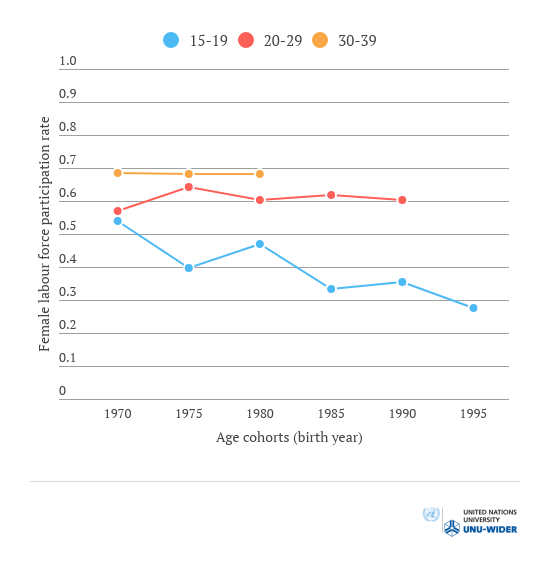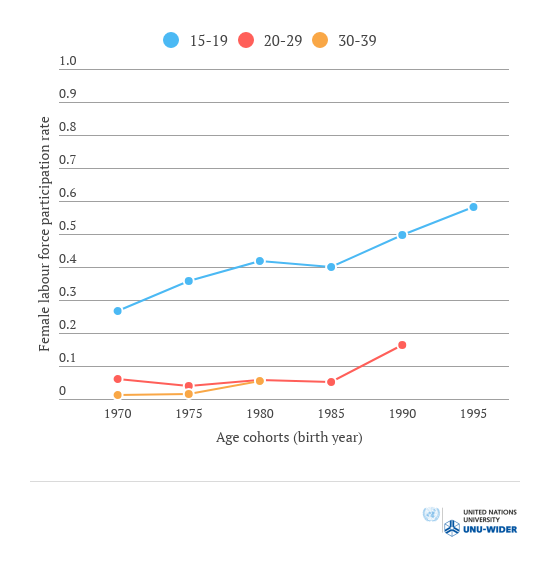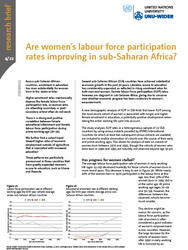Research Brief
Are women’s labour force participation rates improving in sub-Saharan Africa?
Several sub-Saharan African (SSA) countries have achieved substantial economic growth in the past 30 years. Likewise, access to education has considerably expanded, as reflected in rising enrolment rates for both men and women. Female labour force participation (FLFP) rates, however, are stagnant in sub-Saharan Africa, giving rise to concerns over whether economic progress has been conducive to women’s empowerment.
Across sub-Saharan African countries, enrolment in education has risen substantially for women born in the 1990s or later
Higher enrolment rates mechanically depress the female labour force participation rate, as women who are attending secondary or post-secondary school often do not work
There is a strong and positive correlation between female educational attainment and female labour force participation during prime working age (20–39)
We further find a cohort trend toward higher rates of female employment outside of agriculture that is associated with increasing female education
These patterns are particularly pronounced in those countries that have greatly expanded women’s access to education, such as Ghana and Rwanda
A new demographic analysis of FLFP in SSA finds that lower FLFP among the most recent cohort of women is associated with longer and higher female enrolment in education, a potentially positive development when taking the entire working life cycle into account.
The study analyses FLFP rates in a heterogeneous sample of 13 SSA countries by using census extracts provided by IPUMS International. Countries for which at least two subsequent census extracts are available are included to enable observation of cohorts over the course of their early and prime working ages. This allows for analysis of data on cohorts of women born between 1970 and 1995, though the cohorts of women who were born in 1990 and 1995 are naturally not observed beyond age 30 yet.
Has progress for women stalled?
The average labour force participation rate of women in early working life (ages 15–19) decreased markedly for those cohorts of women born in more recent years. This decrease is easy to see in Figure 1A. While nearly 60% of the women born in 1970 participated in the labour force at this age, less than 30% of the women born in 1995 did so at the same age. At prime working age (ages 20–29 and 30–39), however, the differences between the observed cohorts become much smaller.
Figure 1A: Labour force participation rate at different working ages (by birth year cohort): Average across sub-Saharan African countries

This decline might be reason for concern, as the labour force participation rate of women is often considered a good indicator of women’s empowerment across countries. However, the large decrease for the cohorts of women born after 1990 in early working life is mirrored by an increase in women’s secondary school attendance. This is also clearly visible in Figure 1B. At ages 15–19, less than 30% of the women born in 1970 attended school, while nearly 60% of the women born in 1995 were still enrolled in education at the same age.
Figure 1B: Educational enrolment rate at different working ages (by birth year cohort)
Average across sub-Saharan African countries

These two inverse patterns suggest that young women in SSA countries have better access to education now and are taking advantage of it. This increased access to education mechanically depresses the labour force participation rate for women in early working life. As this allows women to enter the labour force later with a higher level of educational attainment, it should not be considered an indicator that women’s empowerment in these countries is necessarily in retreat.
What is the pay-off of increased educational attainment for women?
The inverse association between school attendance and labour force participation at early working age has implications for women’s FLFP across the working life because of its connection to higher women’s educational attainment.
Regression analysis of the data reveals that the association between the FLFP rate and higher levels of education is weak and insignificant until cohort fixed effects are included; then the association turns significant and quantitatively large (Table 1).
These cohort fixed effects, which account for the fact that FLFP in early working life is much lower for the cohorts born in 1990 and 1995 due to their higher school attendance, enable us to see the strong and positive association between women’s educational attainment and their labour force participation rate. A positive association further exists between education and the share of women working in more skill-intensive sectors of the economy.
How the FLFP of the cohorts born in 1990 and 1995 will actually materialize, when these women reach prime working age, remains to be seen in data that are yet to be collected.
Table 1: Results of regression analysis of the association between FLFP and years of schooling
| Dep. Variable | Female labour force participation rate | Non-primary employment share | ||||
|---|---|---|---|---|---|---|
| Years of schooling | 0.01 | 0.01 | 0.01 | 0.11*** | 0.03** | |
| Share w/ university | 2.69*** | |||||
| Share w/ secondary | 0.65*** | |||||
| Cohort observations | 125 | 125 | 125 | 125 | 125 | 96 |
| Country FE | No | Yes | Yes | Yes | Yes | Yes |
| Age group FE | No | No | Yes | Yes | Yes | Yes |
| Cohort FE | No | No | No | Yes | Yes | Yes |
Note: The table shows results from regressing the female labour force participation rate on the female years of schooling (columns 1–-4) and on the share of women that have completed university education and secondary education respectively (column 5), and from regressing the share of women that work in the non-primary sector on the female years of schooling (column 6). Country, age group, and cohort fixed effects (FE) are included in the regressions as indicated.
A potential demographic dividend?
While the younger women of later cohorts have been acquiring more education, their population size has not substantially declined compared to earlier cohorts, an effect described as ‘population momentum’. Consequently, the younger women who are now entering the labour force will have a relatively strong impact on the education level of the overall labour force.
For research, the study demonstrates some of the pitfalls of aggregated data. Such data may obscure substantial cohort movements that are concentrated within narrow age groups
With respect to women’s employment rates over the life cycle, it is further important to disaggregate by age as major life events impacting the rate (such as attending school, being married, and/or becoming a parent) tend to be concentrated in certain age groups
The analysis of these disaggregated trends becomes possible only through the provision of multiple waves of large and representative datasets
The higher investments in education by younger women of recent cohorts can be a major factor contributing to demographic dividends across SSA
The COVID-19 pandemic may adversely affect both female (and male) education and access to the labour market, but this cannot be substantiated yet
Education is generally considered an important factor if a country intends to reap a so-called ‘demographic dividend’ — a boost to its rate of economic growth that originates from a demographic transition towards a larger working-age population, relative to the non-working-age population. In this context, education is considered to improve the economic potential of the growing working-age population.
The relatively large increase in the educational attainment of the female labour force may therefore contribute to demographic dividends across many of the SSA countries studied. At least it has the potential to, if the quality of education is adequate and labour markets in SSA are able to sufficiently create jobs.
 Join the network
Join the network